On Wednesday (October 18th) in the US market, gold prices surged due to the potential escalation of the war between Israel and Hamas, which boosted safe haven demand. Spot gold continued to rise, reaching a high of $1962.66 per ounce in 1960, reaching a new high since August. The final closing was at $1947.68 per ounce, up 1.71% on the day.
According to reports, an explosion at a hospital in Gaza has killed hundreds of Palestinians, marking a possible escalation of the conflict, especially as Egyptian and Palestinian leaders cancelled their meeting with US President Biden after the attack. This move has raised concerns that the conflict between Israel and Hamas may spread to other Arab countries, leading to the spread of the war to the wider Middle East region. This concept has increased investors' demand for safe haven assets. In response, gold has also been continuously climbing higher recently. But there are also opinions that the expansion of the scale of war will increase the risk of inflation. Deutsche Bank stated that the Middle East conflict currently poses significant upward risks. If it spreads to other countries in the region, gold prices may rise first due to its role as a safe haven. But if the Middle East military dispute escalates or expands, oil prices may rise significantly again, increasing the risk of sustained high inflation and potentially triggering further interest rate hikes. Regarding the issue of the US dollar's interest rate, Federal Reserve Governor Warren stated on Wednesday that he hopes to "wait, observe, and see" whether the US economy will continue to maintain strong momentum or show weakness after the Fed's interest rate hikes so far. This statement is a strong signal that the Federal Reserve will not raise interest rates at its next meeting, but it is likely to do so in the future. New York Federal Reserve Bank President Williams also stated on Wednesday that interest rates need to remain high for a period of time in order to bring inflation back to the Fed's target of 2%. Next, officials including Federal Reserve Chairman Powell and others will also give speeches on Thursday. If we also maintain the option of not relaxing interest rate hikes, it will ultimately have a constraining effect on gold, thereby suppressing the momentum of gold reaching its peak.
In terms of technical graphics, the 4-hour random indicator rose, while in terms of morphology, prices resisted a decline. After the price retreated, it continued to rise and tended to continue to fluctuate upwards. On the daily chart, the random indicator is passivated at a high level, while the MACD is bullish. In terms of morphology, there is no possibility of a sharp drop at the break of the bullish line, and the Bollinger Belt is gradually expanding upwards, indicating that the bullish power of gold is currently dominant. The current pressure position above is in 1965, and if it breaks through, it will rush towards the high point in July, around 1983. If there is an adjustment drop when encountering obstacles, the strong support below is in the 1930 1938 area.


